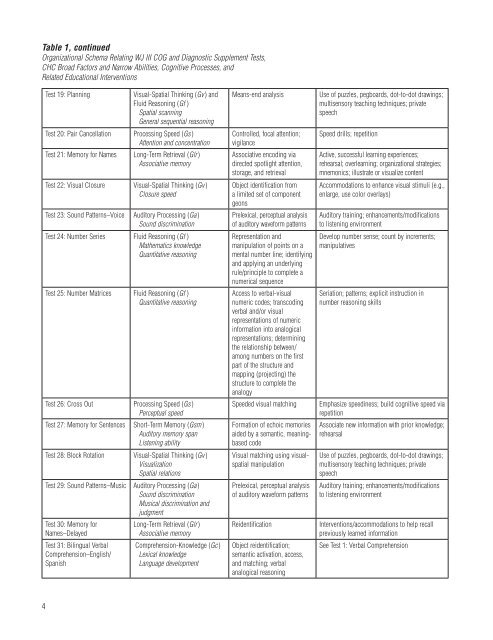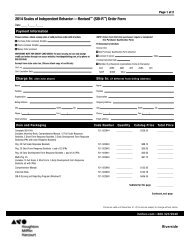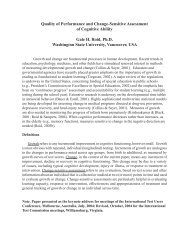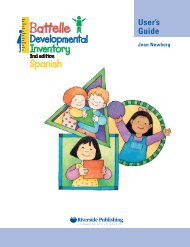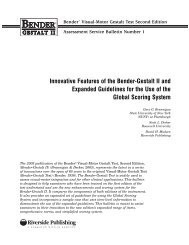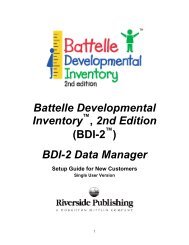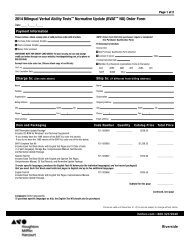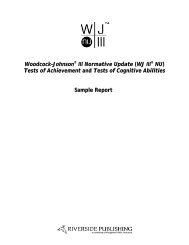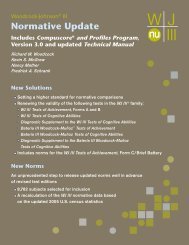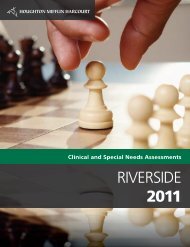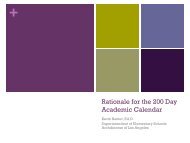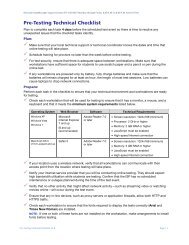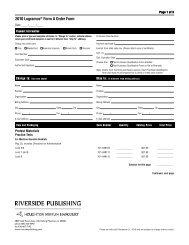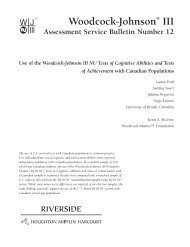Woodcock- Johnson III Tests of Cognitive Abilities - Riverside ...
Woodcock- Johnson III Tests of Cognitive Abilities - Riverside ...
Woodcock- Johnson III Tests of Cognitive Abilities - Riverside ...
You also want an ePaper? Increase the reach of your titles
YUMPU automatically turns print PDFs into web optimized ePapers that Google loves.
Table 1, continuedOrganizational Schema Relating WJ <strong>III</strong> COG and Diagnostic Supplement <strong>Tests</strong>,CHC Broad Factors and Narrow <strong>Abilities</strong>, <strong>Cognitive</strong> Processes, andRelated Educational InterventionsTest 19: PlanningVisual-Spatial Thinking (Gv ) andFluid Reasoning (Gf )Spatial scanningGeneral sequential reasoningTest 20: Pair Cancellation Processing Speed (Gs )Attention and concentrationTest 21: Memory for Names Long-Term Retrieval (Glr )Associative memoryTest 22: Visual Closure Visual-Spatial Thinking (Gv )Closure speedTest 23: Sound Patterns–Voice Auditory Processing (Ga )Sound discriminationTest 24: Number Series Fluid Reasoning (Gf )Mathematics knowledgeQuantitative reasoningTest 25: Number Matrices Fluid Reasoning (Gf )Quantitative reasoningTest 26: Cross Out Processing Speed (Gs )Perceptual speedTest 27: Memory for Sentences Short-Term Memory (Gsm )Auditory memory spanListening abilityTest 28: Block Rotation Visual-Spatial Thinking (Gv )VisualizationSpatial relationsTest 29: Sound Patterns–Music Auditory Processing (Ga )Sound discriminationMusical discrimination andjudgmentTest 30: Memory forNames–DelayedTest 31: Bilingual VerbalComprehension–English/SpanishLong-Term Retrieval (Glr )Associative memoryComprehension-Knowledge (Gc )Lexical knowledgeLanguage developmentMeans-end analysisControlled, focal attention;vigilanceAssociative encoding viadirected spotlight attention,storage, and retrievalObject identification froma limited set <strong>of</strong> componentgeonsPrelexical, perceptual analysis<strong>of</strong> auditory waveform patternsRepresentation andmanipulation <strong>of</strong> points on amental number line; identifyingand applying an underlyingrule/principle to complete anumerical sequenceAccess to verbal-visualnumeric codes; transcodingverbal and/or visualrepresentations <strong>of</strong> numericinformation into analogicalrepresentations; determiningthe relationship between/among numbers on the firstpart <strong>of</strong> the structure andmapping (projecting) thestructure to complete theanalogySpeeded visual matchingFormation <strong>of</strong> echoic memoriesaided by a semantic, meaningbasedcodeVisual matching using visualspatialmanipulationPrelexical, perceptual analysis<strong>of</strong> auditory waveform patternsReidentificationObject reidentification;semantic activation, access,and matching; verbalanalogical reasoningUse <strong>of</strong> puzzles, pegboards, dot-to-dot drawings;multisensory teaching techniques; privatespeechSpeed drills; repetitionActive, successful learning experiences;rehearsal; overlearning; organizational strategies;mnemonics; illustrate or visualize contentAccommodations to enhance visual stimuli (e.g.,enlarge, use color overlays)Auditory training; enhancements/modificationsto listening environmentDevelop number sense; count by increments;manipulativesSeriation; patterns; explicit instruction innumber reasoning skillsEmphasize speediness; build cognitive speed viarepetitionAssociate new information with prior knowledge;rehearsalUse <strong>of</strong> puzzles, pegboards, dot-to-dot drawings;multisensory teaching techniques; privatespeechAuditory training; enhancements/modificationsto listening environmentInterventions/accommodations to help recallpreviously learned informationSee Test 1: Verbal Comprehension


